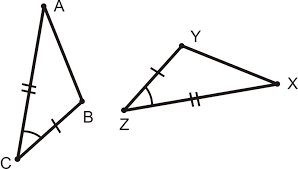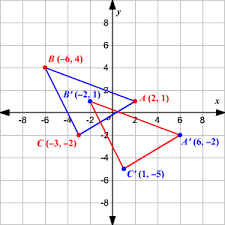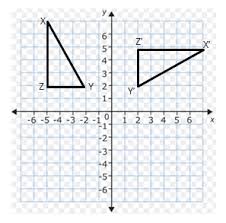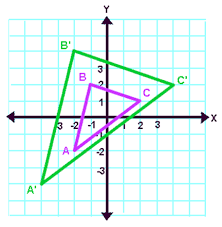Points that are not on the same line
What is noncollinear?
A conditional statement in which the hypothesis and conclusion are switched.
What is the converse?
Lines that are not intersecting yet not parallel
What are skew lines?
A triangle with no sides congruent
What is scalene?
The reflection of point A(3, -5) over the y-axis.
What is A'(-3, -5)?
A line, segment, or ray that divides an angle into two congruent angles.
What is an angle bisector?
The type of conditional statement that is always also true if the original conditional is true.
What is the contrapositive?
Angles marked with b and c

What are alternate interior angles?
The theorem that proves these triangles congruent

What is SAS?
The transformation used here:

What is a translation with vector <4, -3>?
Lines that meet at a 90 degree angle
What is perpendicular?
The postulate used here:
AC = AB + BC

What is the Segment Addition Postulate?
The relationship between the slopes of perpendicular lines
What are opposite reciprocals?
The intersection of these lines is equidistant to all the vertices of a triangle.
What are perpendicular bisectors?
The transformation used here:

What is a rotation of 270o about the origin?
(or 90o clockwise)
Two angles whose sum is 180 degrees.
What are supplementary angles?
The property used here:
If AB = FG and FG = KL, then AB = KL
What is the transitive property?
The point-slope form of an equation of a line parallel to y = 3x + 4 and going through the point (2, -4)
What is y + 4 = 3(x - 2)?
What is 10 and 15?
The transformation used here:

What is a dilation with scale factor 2 centered at the origin?
The coordinates of the endpoint B if M(5, 4) is the midpoint of AB and A is at (-2, 5).
What is (12, 3)?
The measure of x if two vertical angles measure
x + 16 and 4x - 5.
What is 7?
To prove the lines parallel, angles b and d would have to be this

What is supplementary?
CPCTC
What is Corresponding Parts of Congruent Triangles are Congruent?
The types of symmetry the capital letter H has along with specific amounts
What is reflection (or line) symmetry - 2 lines, and rotational symmetry - order 2, magnitude 180o?